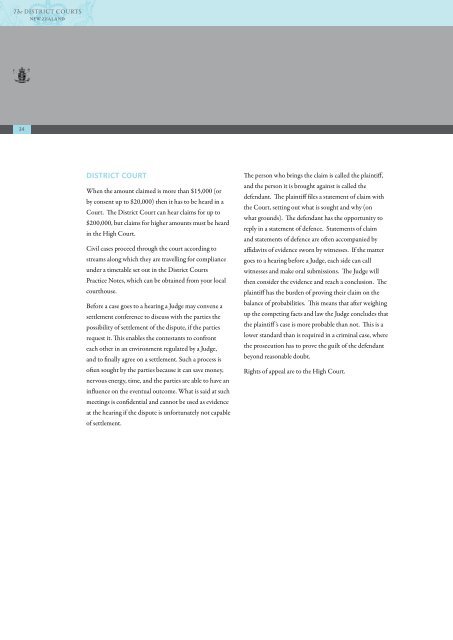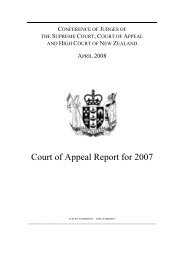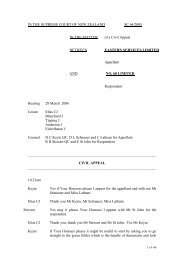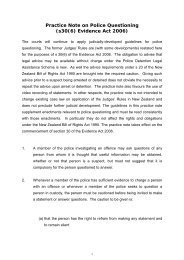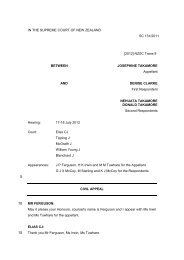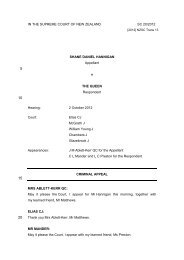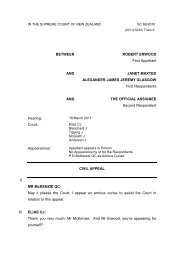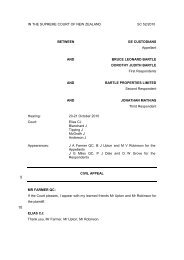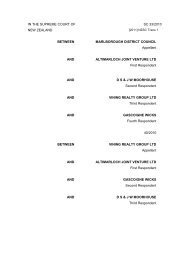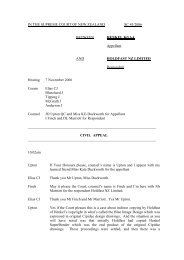DISTRICT COURTS - Courts of New Zealand
DISTRICT COURTS - Courts of New Zealand
DISTRICT COURTS - Courts of New Zealand
Create successful ePaper yourself
Turn your PDF publications into a flip-book with our unique Google optimized e-Paper software.
The <strong>DISTRICT</strong> <strong>COURTS</strong><br />
NEW ZEALAND<br />
34<br />
<strong>DISTRICT</strong> COURT<br />
When the amount claimed is more than $15,000 (or<br />
by consent up to $20,000) then it has to be heard in a<br />
Court. The District Court can hear claims for up to<br />
$200,000, but claims for higher amounts must be heard<br />
in the High Court.<br />
Civil cases proceed through the court according to<br />
streams along which they are travelling for compliance<br />
under a timetable set out in the District <strong>Courts</strong><br />
Practice Notes, which can be obtained from your local<br />
courthouse.<br />
Before a case goes to a hearing a Judge may convene a<br />
settlement conference to discuss with the parties the<br />
possibility <strong>of</strong> settlement <strong>of</strong> the dispute, if the parties<br />
request it. This enables the contestants to confront<br />
each other in an environment regulated by a Judge,<br />
and to finally agree on a settlement. Such a process is<br />
<strong>of</strong>ten sought by the parties because it can save money,<br />
nervous energy, time, and the parties are able to have an<br />
influence on the eventual outcome. What is said at such<br />
meetings is confidential and cannot be used as evidence<br />
at the hearing if the dispute is unfortunately not capable<br />
<strong>of</strong> settlement.<br />
The person who brings the claim is called the plaintiff,<br />
and the person it is brought against is called the<br />
defendant. The plaintiff files a statement <strong>of</strong> claim with<br />
the Court, setting out what is sought and why (on<br />
what grounds). The defendant has the opportunity to<br />
reply in a statement <strong>of</strong> defence. Statements <strong>of</strong> claim<br />
and statements <strong>of</strong> defence are <strong>of</strong>ten accompanied by<br />
affidavits <strong>of</strong> evidence sworn by witnesses. If the matter<br />
goes to a hearing before a Judge, each side can call<br />
witnesses and make oral submissions. The Judge will<br />
then consider the evidence and reach a conclusion. The<br />
plaintiff has the burden <strong>of</strong> proving their claim on the<br />
balance <strong>of</strong> probabilities. This means that after weighing<br />
up the competing facts and law the Judge concludes that<br />
the plaintiff ’s case is more probable than not. This is a<br />
lower standard than is required in a criminal case, where<br />
the prosecution has to prove the guilt <strong>of</strong> the defendant<br />
beyond reasonable doubt.<br />
Rights <strong>of</strong> appeal are to the High Court.


